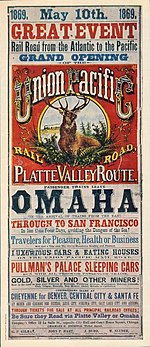The First Transcontinental Railroad in the United States was built across North America in the 1860s, linking the railway network of the Eastern United States with California on the Pacific coast. Ceremonially on May 10, 1869, at the famous Golden spike event at Promontory Summit, Utah, it created a nationwide mechanized transportation network that revolutionized the population and economy of the American West, catalyzing the transition from the wagon trains of previous decades to a modern transportation system. The building of the railway, authorized by the Pacific Railway Act of 1862, required enormous feats of engineering and labor in the crossing of plains and high mountains by the Union Pacific Railroad and Central Pacific Railroad, the two privately chartered, but federally backed enterprises that built the line westward and eastward respectively. Much of the original right-of-way is still in use today and owned by the Union Pacific.
Recently selected: Caledonian Railway - InterCityExpress - Troop sleeper
